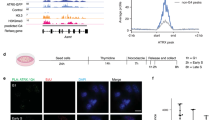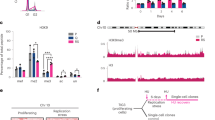Abstract
DNA replication stress is a major source of DNA strand breaks and genomic instability, and a hallmark of precancerous lesions. In these hyperproliferative tissues, activation of the DNA damage response results in apoptosis or senescence preventing or delaying their development to full malignancy. In cells, in which this antitumor barrier is disabled by mutations (for example, in p53), viability and further uncontrolled proliferation depend on factors that help to cope with replication-associated DNA damage. Replication problems preferentially arise in chromatin regions harboring complex DNA structures. DEK is a unique chromatin architectural factor which binds to non-B-form DNA structures, such as cruciform DNA or four-way junctions. It regulates DNA topology and chromatin organization, and is essential for the maintenance of heterochromatin integrity. Since its isolation as part of an oncogenic fusion in a subtype of AML, DEK has been consistently associated with tumor progression and chemoresistance. How DEK promotes cancer, however, is poorly understood. Here we show that DEK facilitates cellular proliferation under conditions of DNA replication stress by promoting replication fork progression. DEK also protects from the transmission of DNA damage to the daughter cell generation. We propose that DEK counteracts replication stress and ensures proliferative advantage by resolving problematic DNA and/or chromatin structures at the replication fork.
This is a preview of subscription content, access via your institution
Access options
Subscribe to this journal
Receive 50 print issues and online access
$259.00 per year
only $5.18 per issue
Buy this article
- Purchase on Springer Link
- Instant access to full article PDF
Prices may be subject to local taxes which are calculated during checkout




Similar content being viewed by others
References
Kappes F, Waldmann T, Mathew V, Yu J, Zhang L, Khodadoust MS et al. The DEK oncoprotein is a Su(var) that is essential to heterochromatin integrity. Genes Dev 2011; 25: 673–678.
Waldmann T, Eckerich C, Baack M, Gruss C . The ubiquitous chromatin protein DEK alters the structure of DNA by introducing positive supercoils. J Biol Chem 2002; 277: 24988–24994.
Cheung TH, Quach NL, Charville GW, Liu L, Park L, Edalati A et al. Maintenance of muscle stem-cell quiescence by microRNA-489. Nature 2012; 482: 524–528.
Wise-Draper TM, Morreale RJ, Morris TA, Mintz-Cole RA, Hoskins EE, Balsitis SJ et al. DEK proto-oncogene expression interferes with the normal epithelial differentiation program. Am J Pathol 2009; 174: 71–81.
Wise-Draper TM, Allen HV, Thobe MN, Jones EE, Habash KB, Münger K et al. The human DEK proto-oncogene is a senescence inhibitor and an upregulated target of high-risk human papillomavirus E7. J Virol 2005; 79: 14309–14317.
Wise-Draper TM, Allen HV, Jones EE, Habash KB, Matsuo H, Wells SI . Apoptosis inhibition by the human DEK oncoprotein involves interference with p53 functions. Mol Cell Biol 2006; 26: 7506–7519.
von Lindern M, Fornerod M, van Baal S, Jaegle M, de Wit T, Buijs A et al. The translocation (6;9), associated with a specific subtype of acute myeloid leukemia, results in the fusion of two genes, dek and can, and the expression of a chimeric, leukemia-specific dek-can mRNA. Mol Cell Biol 1992; 12: 1687–1697.
Kappes F, Khodadoust MS, Yu L, Kim DS, Fullen DR, Markovitz DM et al. DEK expression in melanocytic lesions. Hum Pathol 2011; 42: 932–938.
Khodadoust MS, Verhaegen M, Kappes F, Riveiro-Falkenbach E, Cigudosa JC, Kim DSL et al. Melanoma proliferation and chemoresistance controlled by the DEK oncogene. Cancer Res 2009; 69: 6405–6413.
Wise-Draper TM, Mintz-Cole RA, Morris TA, Simpson DS, Wikenheiser-Brokamp KA, Currier MA et al. Overexpression of the cellular DEK protein promotes epithelial transformation in vitro and in vivo. Cancer Res 2009; 69: 1792–1799.
Saha AK, Kappes F, Mundade A, Deutzmann A, Rosmarin DM, Legendre M et al. Intercellular trafficking of the nuclear oncoprotein DEK. Proc Natl Acad Sci USA 2013; 110: 6847–6852.
Kappes F, Fahrer J, Khodadoust MS, Tabbert A, Strasser C, Mor-Vaknin N et al. DEK is a poly(ADP-ribose) acceptor in apoptosis and mediates resistance to genotoxic stress. Mol Cell Biol 2008; 28: 3245–3257.
Kavanaugh GM, Wise-Draper TM, Morreale RJ, Morrison MA, Gole B, Schwemberger S et al. The human DEK oncogene regulates DNA damage response signaling and repair. Nucleic Acids Res 2011; 39: 7465–7476.
Fahrer J, Popp O, Malanga M, Beneke S, Markovitz DM, Ferrando-May E et al. High-affinity interaction of poly(ADP-ribose) and the human DEK oncoprotein depends upon chain length. Biochemistry 2010; 49: 7119–7130.
Hanahan D, Weinberg RA . Hallmarks of cancer: the next generation. Cell 2011; 144: 646–674.
Alexiadis V, Waldmann T, Andersen J, Mann M, Knippers R, Gruss C . The protein encoded by the proto-oncogene DEK changes the topology of chromatin and reduces the efficiency of DNA replication in a chromatin-specific manner. Genes Dev 2000; 14: 1308–1312.
Waldmann T, Baack M, Richter N, Gruss C . Structure-specific binding of the proto-oncogene protein DEK to DNA. Nucleic Acids Res 2003; 31: 7003–7010.
Riveiro-Falkenbach E, Soengas MS . Control of tumorigenesis and chemoresistance by the DEK oncogene. Clin Cancer Res 2010; 16: 2932–2938.
Bartkova J, Horejsi Z, Koed K, Kramer A, Tort F, Zieger K et al. DNA damage response as a candidate anti-cancer barrier in early human tumorigenesis. Nature 2005; 434: 864–870.
Halazonetis TD, Gorgoulis VG, Bartek J . An oncogene-induced DNA damage model for cancer development. Science 2008; 319: 1352–1355.
Bartek J, Mistrik M, Bartkova J . Thresholds of replication stress signaling in cancer development and treatment. Nat Struct Mol Biol 2012; 19: 5–7.
Murga M, Campaner S, Lopez-Contreras AJ, Toledo LI, Soria R, Montana MF et al. Exploiting oncogene-induced replicative stress for the selective killing of Myc-driven tumors. Nat Struct Mol Biol 2011; 18: 1331–1335.
Petermann E, Orta ML, Issaeva N, Schultz N, Helleday T . Hydroxyurea-stalled replication forks become progressively inactivated and require two different RAD51-mediated pathways for restart and repair. Mol Cell 2010; 37: 492–502.
Trenz K, Smith E, Smith S, Costanzo V . ATM and ATR promote Mre11 dependent restart of collapsed replication forks and prevent accumulation of DNA breaks. EMBO J 2006; 25: 1764–1774.
Lukas C, Savic V, Bekker-Jensen S, Doil C, Neumann B, Pedersen RS et al. 53BP1 nuclear bodies form around DNA lesions generated by mitotic transmission of chromosomes under replication stress. Nat Cell Biol 2011; 13: 243–253.
Wilhelm T, Magdalou I, Barascu A, Techer H, Debatisse M, Lopez BS . Spontaneous slow replication fork progression elicits mitosis alterations in homologous recombination-deficient mammalian cells. Proc Natl Acad Sci USA 2014; 111: 763–768.
Ray Chaudhuri A, Hashimoto Y, Herrador R, Neelsen KJ, Fachinetti D, Bermejo R et al. Topoisomerase I poisoning results in PARP-mediated replication fork reversal. Nat Struct Mol Biol 2012; 19: 417–423.
Debatisse M, Le Tallec B, Letessier A, Dutrillaux B, Brison O . Common fragile sites: mechanisms of instability revisited. Trends Genet 2012; 28: 22–32.
de Feraudy S, Revet I, Bezrookove V, Feeney L, Cleaver JE . A minority of foci or pan-nuclear apoptotic staining of gammaH2AX in the S phase after UV damage contain DNA double-strand breaks. Proc Natl Acad Sci USA 2010; 107: 6870–6875.
Sirbu BM, McDonald WH, Dungrawala H, Badu-Nkansah A, Kavanaugh GM, Chen Y et al. Identification of proteins at active, stalled, and collapsed replication forks using isolation of proteins on nascent DNA (iPOND) coupled with mass spectrometry. J Biol Chem 2013; 288: 31458–31467.
Hashimoto Y, Ray Chaudhuri A, Lopes M, Costanzo V . Rad51 protects nascent DNA from Mre11-dependent degradation and promotes continuous DNA synthesis. Nat Struct Mol Biol 2010; 17: 1305–1311.
Wang LC, Stone S, Hoatlin ME, Gautier J . Fanconi anemia proteins stabilize replication forks. DNA Repair (Amst) 2008; 7: 1973–1981.
Naim V, Rosselli F . The FANC pathway and BLM collaborate during mitosis to prevent micro-nucleation and chromosome abnormalities. Nat Cell Biol 2009; 11: 761–768.
Bogliolo M, Lyakhovich A, Callén E, Castellà M, Cappelli E, Ramírez MJ et al. Histone H2AX and Fanconi anemia FANCD2 function in the same pathway to maintain chromosome stability. EMBO J 2007; 26: 1340–1351.
Renaud E, Rosselli F . FANC pathway promotes UV-induced stalled replication forks recovery by acting both upstream and downstream Poleta and Rev1. PLoS ONE 2013; 8: e53693.
Schlacher K, Wu H, Jasin M . A distinct replication fork protection pathway connects Fanconi anemia tumor suppressors to RAD51-BRCA1/2. Cancer Cell 2012; 22: 106–116.
Chan KL, Palmai-Pallag T, Ying S, Hickson ID . Replication stress induces sister-chromatid bridging at fragile site loci in mitosis. Nat Cell Biol 2009; 11: 753–760.
Harrigan JA, Belotserkovskaya R, Coates J, Dimitrova DS, Polo SE, Bradshaw CR et al. Replication stress induces 53BP1-containing OPT domains in G1 cells. J Cell Biol 2011; 193: 97–108.
Mor-Vaknin N, Punturieri A, Sitwala K, Faulkner N, Legendre M, Khodadoust MS et al. The DEK nuclear autoantigen is a secreted chemotactic factor. Mol Cell Biol 2006; 26: 9484–9496.
Acknowledgements
We thank G Marra for U2-OS cells, Y Marquardt for NHD fibroblasts, J Schmidt for ImageJ Macro programming, D Hermann, K Weidele and F Teusel for technical assistance; S Bürger and the FlowKon facility for support in flow cytometry and M Lopes, C Lukas, A Bürkle and B Lüscher for fruitful discussions. This work was supported by the German Research Foundation (DFG) through funds of the SFB 969, and of the RTG 1331. Work in the laboratory of FK is supported by a DFG grant (KA 2799/1) and by the START program of the Faculty of Medicine, RWTH Aachen.
Author information
Authors and Affiliations
Corresponding author
Ethics declarations
Competing interests
The authors declare no conflict of interest.
Additional information
Supplementary Information accompanies this paper on the Oncogene website
Rights and permissions
About this article
Cite this article
Deutzmann, A., Ganz, M., Schönenberger, F. et al. The human oncoprotein and chromatin architectural factor DEK counteracts DNA replication stress. Oncogene 34, 4270–4277 (2015). https://doi.org/10.1038/onc.2014.346
Received:
Revised:
Accepted:
Published:
Issue Date:
DOI: https://doi.org/10.1038/onc.2014.346
This article is cited by
-
PG545 sensitizes ovarian cancer cells to PARP inhibitors through modulation of RAD51-DEK interaction
Oncogene (2023)
-
TFEB-VEGFA (6p21.1) co-amplified renal cell carcinoma: a distinct entity with potential implications for clinical management
Modern Pathology (2017)
-
DEK is required for homologous recombination repair of DNA breaks
Scientific Reports (2017)



